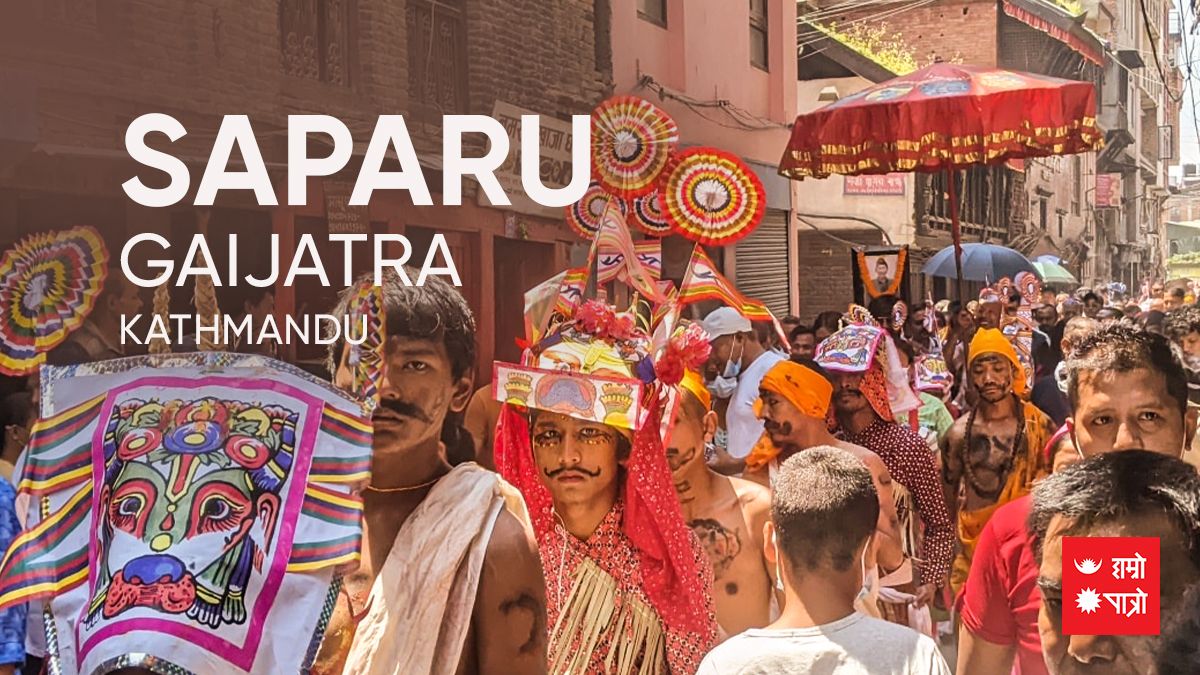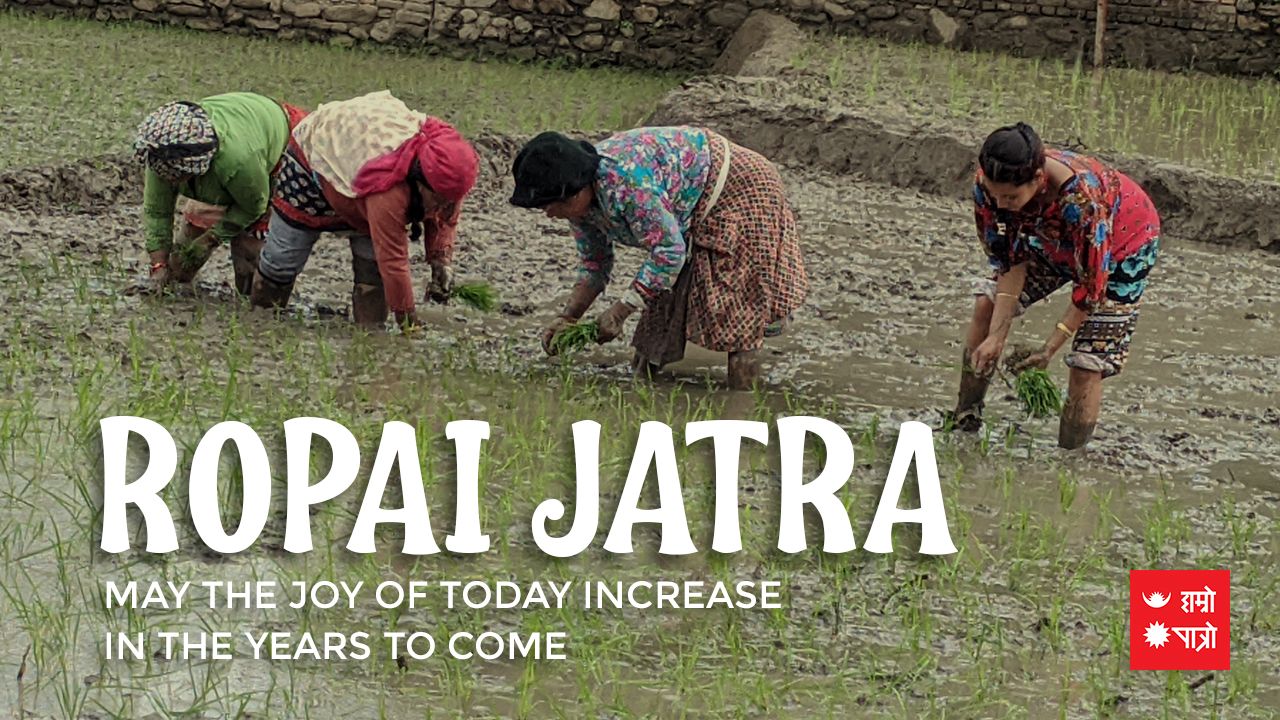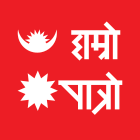Upcomming Events
-
29MangsirSafala Ekadashi Vrata tomorrow
-
1PaushDhanu Sankranti 2 days remaning
-
2PaushPradosh Vrata 3 days remaning
-
3PaushInternational Immigrants Day 4 days remaning
-
5PaushTol Lhosar 6 days remaning
-
6PaushWorld Meditation Day 7 days remaning
-
10PaushChristmas 11 days remaning
-
13PaushGorakhkali Puja 14 days remaning
-
15PaushTamu Lhosar/Kavi Siromani Lekhnath Jayanti/Putrada Ekadashi Vrata 16 days remaning
-
17PaushNew Year 2026/Pradosh Vrata/Topi Day/Poshak Day 18 days remaning
-
19PaushSri Swasthani Vrata Katha Prarambha/Maagh Snan/Poornima Vrata 20 days remaning
-
21PaushGuru Gobinda Singh Jayanti 22 days remaning
-
23PaushAraniko Smriti Day 24 days remaning
-
24PaushNepal Astrology Council Establishment Day 25 days remaning
-
27PaushPrithivi Jayanti/Rashtriya Ekata Diwas/Gorakhkali Puja 28 days remaning
-
29PaushNational Bhakka Day 30 days remaning
-
30PaushShattila Ekadashi 31 days remaning
-
1MaghMakar Sankranti/Ghiu chaku khane Din/Uttarayan Arambha 32 days remaning
-
2MaghNational Earthquake Safety Day/Pradosh Vrata 33 days remaning
-
5MaghSonam Lhochhar/Shree Ballav Jayanti 36 days remaning
-
8MaghTilkunda Chauthi 39 days remaning
-
9MaghBasanta Panchami vrata/Saraswati Pooja 40 days remaning
-
10MaghSkanda Sasti/Achala Saptami/International Day of Education 41 days remaning
-
11MaghGorakhkali Puja/World Leprosy Day 42 days remaning
-
12MaghInternational Custom Day 43 days remaning
-
13MaghDron Nawami 44 days remaning
-
15MaghBhima Ekadashi Vrata 46 days remaning
-
16MaghSahid Diwas/Pradosh Vrata 47 days remaning
-
18MaghShree Swasthani Brata Samapti/Poornima Wrata 49 days remaning
-
19MaghWorld Wetlands Day 50 days remaning
-
21MaghWorld Cancer Day 52 days remaning
-
25MaghRavisaptami Vrata 56 days remaning
-
26MaghGorakhkali Puja 57 days remaning
-
28MaghInternational Day of Women and Girls in Science/Safer Internet Day 59 days remaning
-
1FalgunKumbha Sankranti/Bijaya Ekadashi Vrata/World Radio Day 61 days remaning
-
2FalgunShani Pradosh Vrata/Valentine's Day 62 days remaning
-
3FalgunMaha-Shivaratri / Army Day/Silachahre Puja 63 days remaning
-
6FalgunGyalpo Lhosar 66 days remaning
-
7FalgunPrajatantra Diwas / Election Day 67 days remaning
-
8FalgunWorld Day of Social Justice 68 days remaning
Jyotish
-
Jyotish Narayan Prasad Bhandariज्योतिषका उप-प्राध्यापक (lecturer of A...
-
 Jyotish Mukunda Sharmaस्वाध्याय, सत्सङ्ग र सदाचारजस�...
Jyotish Mukunda Sharmaस्वाध्याय, सत्सङ्ग र सदाचारजस�...
-
Jyotish Vaman Sapkotaशिक्षा - व्याकरणाचार्य, पौरोही...
-
Jyotish Pandit Mukunda Nepalज्योतिष पण्डित मुकुन्द नेपाल�...
-
Jyotish Mohan Ghimireसम्पुर्णानन्द संस्कृत विश्वव...
-
Jyotish Damodar Poudelनेपाल संस्कृत विश्व बिद्यालय�...
-
Jyotish Amrit Paudelवाराणसीकै सम्पूर्णानन्द संस्...
-
Jyotish Purushottam Ghimireनेपाल संस्कृत विश्वविद्यालय, �...
-
Jyotish Smarika Acharyaबाल्मीकि बिद्यापिठ बाट ज्योत�...
-
Jyotish Krishna Prasad Bhandariउपप्राध्यापक (Asst. professor of Sanskrit) नेपा�...
-
 Jyotish Dharmendra Krishna Paudelशास्त्री धर्मेन्द्र कृष्ण पौ�...
Jyotish Dharmendra Krishna Paudelशास्त्री धर्मेन्द्र कृष्ण पौ�...
-
Jyotish Dipendra Khatiwadaसम्पुर्णानन्द संस्कृत बिश्वब...
-
Jyotish Narayan Prasad Gautamगुरुकुल शिक्षा प्रणालीबाट ज्�...
-
 Jyotish Kuresh Pandey११ वर्षको अनुभवसहित विभिन्न ध�...
Jyotish Kuresh Pandey११ वर्षको अनुभवसहित विभिन्न ध�...
-
Jyotish Deepak Prasad Kafleसम्पूर्णानन्द संस्कृत विश्वव...
-
Jyotish Damodar Kaushikज्योतिष र व्याकरण विषयमा आचार�...
-
Jyotish Ghanashyam Pokharelनेपाल संस्कृत विश्वविद्यालयब...
-
Jyotish Khageshwor Subediगुरुकुल पद्दति बाट ज्योतिषीय �...
-
Acharya Choodamani Pathakसम्पूर्णानन्दसंस्कृत विश्वव�...
-
Jyotish Dr. Janak Bhattaविगत ३५ वर्षदेखि कुण्डली निर्�...
-
Jyotish Khagendra Subediसम्पूर्णानंद संस्कृत विश्ववि...
Hororscope
Saparu (GaiJatra)/Ropai Jatra

Gaijatra: Acknowledgement of smiles in Nepali society.
Welcome to Gaijatra, a day of smiles that forgets these jatras of separation and destruction and transforms everything into simple happiness and harmony.
Importance of "Cow" in Sanatana Culture
Probably the first essay written by many of us in student life was about cows. Not only the Vedic Sanatan rites but also the Indus Valley Civilization and in Bharat Barsa, the cow is worshiped as a symbol of special respect and faith in religious and cultural occasions in daily life. The Gaijatra festival is also an example of such cultural significance. This pilgrimage is very important especially for the family members who lost their loved ones in the last year as it is a special place of remembrance, affection, and closeness of the deceased.
Saparu
In Nepal Bhasa, "Gaijatra" is called "Saparu". The streets are ablaze with cows, cow-disguises, and jhankis with various masks. In Gaijatra, various funny conversations, jokes, sarcasm, and even stand-up comedy are performed.
Background of Gaijatra
Considering the means of fun and laughter in the procession in memory of the deceased relatives, Gaijatra seems to call on the bereaved family of the deceased to move forward as a necessary process of life. Cow and Jatra i.e. this day is also the Jatra of cow revered in Hindu rites as mother and earth. According to legends written in the pages of history, the people of Kathmandu Valley worship Yama, the god of death, on this day. From BS 1641 to 1664, King Pratap Malla's queen was very much devastated by the death of her infant son.
Although the king tried to explain the fact that it was a moment that no one could control, the queen couldn't overcome the melancholy. Later, King came up with a plan which continues as Gaijatra even after hundreds of years. King Pratap Malla called upon the relatives of the citizens who had died in the state during the year in which he lost his minor son to take a procession from the front of the palace with cows.
On this day, the procession was displayed in the present Kathmandu Durbar Square and the new exhibition caught everyone's attention. Seeing many family members who lost their loved ones in her memory, the queen felt that she was not the only one to mourn the death. As the king encouraged the people to include various jokes, senses of humor and acts in the procession, the queen largely laughed after seeing all these things.
On the other hand, the people who came in the procession started to symbolically explain the pomp of the rich people of the society and the suffering of the poor through various exhibitions and tableaus. That is to say, Gaijatra is also a festival of artistically exposing the negative aspects of the current social, cultural, and political activities in society.
At that time, the people satirically presented to the king and queen the examples of oppression and injustice done by the society towards the poor and helpless. The practice of bang, which was started in Gaijatra, has been passed down from generation to generation and is still practiced today to target politicians, media persons, and other eminent persons of the society.
No one is allowed to hold a grudge against the bang made in Gaijatra. When the cow is taken out, the cow is brought forward and if there is no cow, the Kumar boy is brought forward like a cow. Gaijatra is celebrated across Nepal.
On the other hand, Gaijatra also indicates that the monsoon end and festivals are approaching. The setting sun, the bright days, the chilling wind, and the finished planting of the field. In this sense, Gaijatra is also an opportunity to laugh freely on a leisurely day. There will be performances and gatherings of national and local artists from all over the country including Kathmandu. Such Gaijatra special programs last for 10 to 15 days.
TV, radio, and newspapers have been Gai Jatra filled during this period. From the Gulf to the United States, Europe, and Japan, Gaijatra is celebrated in various forms and formats wherever Nepalis are.
May this year's Gaijatra bring laughter and happiness to the mountains, hills, and the Terai. Let the perversion and corruption be exposed, let the transparency be praised. Smiles, smiles, and just smiles.
Ropai Jatra

Background of Ropai Jatra
In our agricultural country, monsoon is of great importance every year. In some places, there was enough rain and in some places, the challenges of planting increased due to lack of rain. But, somewhere slow, somewhere fast, somewhere easy, somewhere facing many difficulties, paddy is being planted. On the occasion of the completion of "Ropai", the biggest festival of the farmers of our agricultural country, "Ropai Jatra" is celebrated in different parts of the country today.
Especially the Newa: Ropainjatra started by the community has become a celebration for everyone across the country. In Nepali, "Ropai Jatra" is called "Sinajya Jatra".
Celabration of Ropai Jatra
Celebrated all over the country to forget the fatigue and stress of transplanting, this festival is celebrated in different ways in different places. In the Karnali region, this procession is called "Chopai". In the local language, "chopai" means "chopnu" or dipping something into water. Today, the people of all the cities and villages are playing various instruments in their villages and dancing for planting paddy. Farmers gather and play the instruments, sing and dance the songs of sowing and reach the paddy field to have fun.
Today, there is a belief in many places that the real owner of a paddy field should be thrown in the mud of his field, this is a humorous belief which makes the owner close with his soil and roots. Special wishes to all the brothers and sisters of this agricultural country. May the joy of today increase in the years to come.
Suyog Dhakal
Upcomming Events
-
29MangsirSafala Ekadashi Vrata tomorrow
-
1PaushDhanu Sankranti 2 days remaning
-
2PaushPradosh Vrata 3 days remaning
-
3PaushInternational Immigrants Day 4 days remaning
-
5PaushTol Lhosar 6 days remaning
-
6PaushWorld Meditation Day 7 days remaning
-
10PaushChristmas 11 days remaning
-
13PaushGorakhkali Puja 14 days remaning
-
15PaushTamu Lhosar/Kavi Siromani Lekhnath Jayanti/Putrada Ekadashi Vrata 16 days remaning
-
17PaushNew Year 2026/Pradosh Vrata/Topi Day/Poshak Day 18 days remaning
-
19PaushSri Swasthani Vrata Katha Prarambha/Maagh Snan/Poornima Vrata 20 days remaning
-
21PaushGuru Gobinda Singh Jayanti 22 days remaning
-
23PaushAraniko Smriti Day 24 days remaning
-
24PaushNepal Astrology Council Establishment Day 25 days remaning
-
27PaushPrithivi Jayanti/Rashtriya Ekata Diwas/Gorakhkali Puja 28 days remaning
-
29PaushNational Bhakka Day 30 days remaning
-
30PaushShattila Ekadashi 31 days remaning
-
1MaghMakar Sankranti/Ghiu chaku khane Din/Uttarayan Arambha 32 days remaning
-
2MaghNational Earthquake Safety Day/Pradosh Vrata 33 days remaning
-
5MaghSonam Lhochhar/Shree Ballav Jayanti 36 days remaning
-
8MaghTilkunda Chauthi 39 days remaning
-
9MaghBasanta Panchami vrata/Saraswati Pooja 40 days remaning
-
10MaghSkanda Sasti/Achala Saptami/International Day of Education 41 days remaning
-
11MaghGorakhkali Puja/World Leprosy Day 42 days remaning
-
12MaghInternational Custom Day 43 days remaning
-
13MaghDron Nawami 44 days remaning
-
15MaghBhima Ekadashi Vrata 46 days remaning
-
16MaghSahid Diwas/Pradosh Vrata 47 days remaning
-
18MaghShree Swasthani Brata Samapti/Poornima Wrata 49 days remaning
-
19MaghWorld Wetlands Day 50 days remaning
-
21MaghWorld Cancer Day 52 days remaning
-
25MaghRavisaptami Vrata 56 days remaning
-
26MaghGorakhkali Puja 57 days remaning
-
28MaghInternational Day of Women and Girls in Science/Safer Internet Day 59 days remaning
-
1FalgunKumbha Sankranti/Bijaya Ekadashi Vrata/World Radio Day 61 days remaning
-
2FalgunShani Pradosh Vrata/Valentine's Day 62 days remaning
-
3FalgunMaha-Shivaratri / Army Day/Silachahre Puja 63 days remaning
-
6FalgunGyalpo Lhosar 66 days remaning
-
7FalgunPrajatantra Diwas / Election Day 67 days remaning
-
8FalgunWorld Day of Social Justice 68 days remaning
Jyotish
-
Jyotish Narayan Prasad Bhandariज्योतिषका उप-प्राध्यापक (lecturer of A...
-
 Jyotish Mukunda Sharmaस्वाध्याय, सत्सङ्ग र सदाचारजस�...
Jyotish Mukunda Sharmaस्वाध्याय, सत्सङ्ग र सदाचारजस�...
-
Jyotish Vaman Sapkotaशिक्षा - व्याकरणाचार्य, पौरोही...
-
Jyotish Pandit Mukunda Nepalज्योतिष पण्डित मुकुन्द नेपाल�...
-
Jyotish Mohan Ghimireसम्पुर्णानन्द संस्कृत विश्वव...
-
Jyotish Damodar Poudelनेपाल संस्कृत विश्व बिद्यालय�...
-
Jyotish Amrit Paudelवाराणसीकै सम्पूर्णानन्द संस्...
-
Jyotish Purushottam Ghimireनेपाल संस्कृत विश्वविद्यालय, �...
-
Jyotish Smarika Acharyaबाल्मीकि बिद्यापिठ बाट ज्योत�...
-
Jyotish Krishna Prasad Bhandariउपप्राध्यापक (Asst. professor of Sanskrit) नेपा�...
-
 Jyotish Dharmendra Krishna Paudelशास्त्री धर्मेन्द्र कृष्ण पौ�...
Jyotish Dharmendra Krishna Paudelशास्त्री धर्मेन्द्र कृष्ण पौ�...
-
Jyotish Dipendra Khatiwadaसम्पुर्णानन्द संस्कृत बिश्वब...
-
Jyotish Narayan Prasad Gautamगुरुकुल शिक्षा प्रणालीबाट ज्�...
-
 Jyotish Kuresh Pandey११ वर्षको अनुभवसहित विभिन्न ध�...
Jyotish Kuresh Pandey११ वर्षको अनुभवसहित विभिन्न ध�...
-
Jyotish Deepak Prasad Kafleसम्पूर्णानन्द संस्कृत विश्वव...
-
Jyotish Damodar Kaushikज्योतिष र व्याकरण विषयमा आचार�...
-
Jyotish Ghanashyam Pokharelनेपाल संस्कृत विश्वविद्यालयब...
-
Jyotish Khageshwor Subediगुरुकुल पद्दति बाट ज्योतिषीय �...
-
Acharya Choodamani Pathakसम्पूर्णानन्दसंस्कृत विश्वव�...
-
Jyotish Dr. Janak Bhattaविगत ३५ वर्षदेखि कुण्डली निर्�...
-
Jyotish Khagendra Subediसम्पूर्णानंद संस्कृत विश्ववि...
Hororscope
Liked by:




















 Mesh
Mesh Brish
Brish Mithun
Mithun Karkat
Karkat  Singha
Singha  Kanya
Kanya Tula
Tula Brischik
Brischik Dhanu
Dhanu  Makar
Makar  Kumbha
Kumbha Meen
Meen